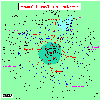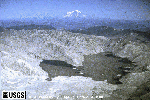Monitoring Mount St. Helens VolcanoAn Introduction |
|||||||||||||||||||||||||||||||||||

Monitoring Mount St. Helens
In response to renewed eruptive activity at Mount St. Helens in 1980,
the Cascades Volcano Observatory (CVO) was established
in Vancouver, Washington, with the support of the
U. S. Geological Survey's Volcano Hazards Program.
-- Chadwick, Iwatsubo, Swanson, and Ewert, 1985
Earthquake MonitoringEarthquakes commonly provide the earliest warning of volcanic unrest, and earthquake swarms immediately precede most volcanic eruptions. Information on Pacific Northwest earthquake activity and hazards is provided by the Pacific Northwest Seismograph Network (PNSN) which operates seismograph stations and locates earthquakes in Washington and Oregon. The PNSN is operated jointly by the University of Washington, the University of Oregon, and Oregon State University, and is funded by the U.S. Geological Survey, the Department of Energy, and the State of Washington. The PNSN is based at the Geophysics Program of the University of Washington in Seattle, and is a member of the Council of the National Seismic Systems (CNSS), a group of regional network operators who cooperate to locate and catalog earthquakes throughout the United States. -- Wright and Pierson, 1992; and University of Washington's Geophysics Program
Geochemical Studies
Geochemical studies include temperature
measurements and gas sampling of
fumaroles.
Changes in fumarole gas composition, or in the
emission rate of SO2
and other gases, may be related to variation in magma supply rate,
change in magma type,
or modifications in the pathways of gas escape induced by magma movement.
-- Chadwick, Iwatsubo, Swanson, and Ewert, 1985; and
Wright and Pierson, 1992
Geodetic NetworksGeodetic networks are set up to measure the changing shape of the volcano surface caused by the pressure of magma moving underground. Techniques commonly used include electronic distance measurement using a laser light source (EDM); measurement of tilt, both electronically and by repeated leveling of triangular arrays; and standard leveling surveys to obtain elevation changes. Additionally, very simple and inexpensive techniques, such as measuring crack openings using a steep tape, or noting changes in water level around a crater lake, have proven useful in certain situations. Upward and outward movement of the ground above a magma storage area commonly occurs before eruption. Localized ground displacement on steep volcanoes may indicate slope instability precursory to mass failure.
These
networks,
once the baseline information has been collected, can detect
surface deformation that may reflect magma movement up the conduit. The rates
of deformation increase as magma approaches the surface, and these measurements
can therefore help determine where and when an eruption may occur.
-- Wright and Pierson, 1992; and Iwatsubo and Swanson, 1992
Dome MonitoringMount St. Helens 1995 EDM network for monitoring the dome. There are 4 instrument stations: Swani (2 kilometers north of the dome), Lonesome, Earl, and Little Village. Both distance and angles (vertical and horizontal) are shot to each target. -- CVO Volcano Deformation Project
Trilateration NetworkAs part of the geodetic monitoring program at Mount St. Helens, CVO established a trilateration network to monitor far field deformation of the volcano. The networks are: the "far out net" (blue lines) and the "outer net" (red lines). Both were established in 1980. The "far out net" has been remeasured several times since 1980 and shows changes within measurement errors. The "outer net" has been measured frequently until 1985, then sporadically until 1993, when the network was measured with GPS (global positioning system). Red colored names are instrument stations for the "outer net". -- CVO Volcano Deformation Project
Hydrologic MonitoringChanges in ground water temperature or level, rates of streamflow and transport of stream sediment, lake levels, and snow and ice accumulation are recorded to evaluate (1) the role of ground water in generating eruptions, (2) the potential hazards when hot, energetic volcanic products interact with snow, ice, and surface streams, and (3) the long-term hazard of infilling of river channels leading to increased flood potential. -- Wright and Pierson, 1992 Gaging stations were constructed after the May 18 eruption to measure water and sediment discharge of the rivers draining Mount St. Helens; these stations supplement those already in place on reservoirs and rivers around the volcano. The network of river gages provide information for flood forecasting and for long-term sediment-transport trends. These data are used by the National Weather Service to warn of severe flooding conditions and by the Corps of Engineers to develop sediment-control solutions. -- Brantley and Topinka, 1984
More than 150 cross-sections of river channels are surveyed regularly to determine areas of erosion and deposition along rivers draining Mount St. Helens. These repetitive surveys measure bank and channel erosion and channel deposition at specific locations. -- Brantley and Topinka, 1984
The May 18, 1980, debris avalanche raised the level of Spirit Lake 64 meters (210 feet) and dammed its natural outlet even higher. Several lakes formed in tributaries dammed by the avalanche; the largest lakes formed in the tributaries of Coldwater and Castle Creeks. Failure of the debris dams holding Spirit, Coldwater, and Castle Lakes would result in catastrophic mudflows comparable to or larger than those of May 18, 1980. Controlled outflow channels have been constructed by the U.S. Army Corp of Engineers to stabilize the water levels. Lake gages, maintained by the Geological Survey in cooperation with the National Weather Service and the Federal Emergency Management Agency, monitor the water levels of Spirit, Coldwater, and Castle Lakes. The gages serve as an emergency warning system if one of the debris dams fails. Each gage has at least two recording instruments that transmit several lake elevations each hour by way of a satellite to a ground receiving station in Tacoma, Washington. If a lake level drops faster than the specified rate, alert transmissions send lake elevations every 5 minutes. -- Brantley and Topinka, 1984
Emergency ResponseDuring the 1980-86 eruptions of Mount St. Helens, hazards information was quickly disseminated through a U. S. Geological Survey Cascades Volcano Observatory - U. S. Forest Service notification system. Written and verbal statements issued jointly by the Cascades Volcano Observatory (CVO) and University of Washington (UW) were released to the U. S. Forest Service (USFS) for telephone call-down to governmental agencies and private interests. Once the call-down was underway, public and media information tapes were updated and press releases were issued. Because most of these eruptions had recognizable precursors, a series of information statements and eruption forecasts was issued during the weeks to hours before and eruption, thus providing advance warning of volcanic activity and associated hazards. The occurrence of occasional small, unpredictable, ash-producing explosions at Mount St. Helens during 1989-91, coupled with increased concern about the hazards of volcanic ash to aviation, prompted CVO to develop a real-time seismic-amplitude seismic-amplitude alarm system (RSAM) that triggers on small volcanic events.
This alarm system activates CVO's 24-hour telephone beeper. In addition, the Federal Aviation Administration (FAA) can also activate the CVO beeper to report possible volcanic activity. These two modifications improve CVO's response time for non-predictable, sudden-onset events and help the FAA quickly verify pilot reports of possible volcanic plumes. -- Myers and Theisen, 1994 |
|||||||||||||||||||||||||||||||||||

 [Map,30K,InlineGIF]
[Map,30K,InlineGIF] [Map,16K,InlineGIF]
[Map,16K,InlineGIF] [Graphic,20K,InlineGIF]
[Graphic,20K,InlineGIF] [Graphic,30K,InlineGIF]
[Graphic,30K,InlineGIF] [Interactive Imagemap]
[Interactive Imagemap] [Image,38K,JPG]
[Image,38K,JPG] [Graphic,14K,GIF]
[Graphic,14K,GIF] [Image,45K,JPG]
[Image,45K,JPG]